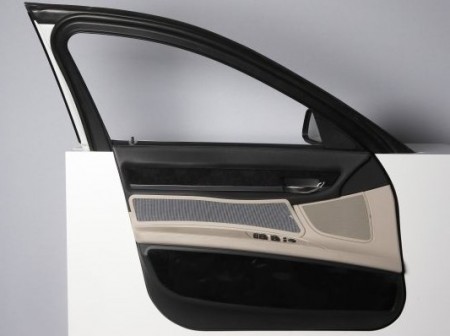Sep
21
BMW Leads By Thinking Heat Pump and Infrared for the Car
September 21, 2012 | Leave a Comment
The BMW Group’s Efficient Dynamics strategy is hunting for reductions in fuel consumption and CO2 emissions. The targets are out there; BMW is looking at the battery electric vehicles, the full plug-ins, and the hybrids. The goal is to increase performance in the typical BMW fashion. The performance this time is range – distance traveled on the full charge.
One target is labeled “Intelligent Energy Management”. The BMW group is working on a variety of individual solutions that help to reduce energy consumption by the ancillary systems needed in vehicles. Thus every kilowatt of stored energy that can be saved becomes available to the electric motor, enabling a greater operating range. And BMW is fully aware some of these new techniques could also be transferred to future vehicles with internal combustion engines.
Of particular interest is the area of passenger compartment heating and cooling. Here BMW is exploring the use of heat pumps and infrared systems.
Designing for electric vehicles at low outside temperatures is especially challenging when seeking to deliver the required heating capacity to heat or cool the passenger compartment efficiently.
Heat pumps, a technology widely applied in the domestic housing sector, represent one approach. BMW points out that to really take advantage of the higher efficiency of the heat pump compared to pure battery-driven electric heating alone, the technology needs to work reliably under all driving conditions.
Just like systems used for heating buildings, the heat pump in the vehicle uses ambient heat – in this case, the heat from the surrounding air. By means of an air conditioning compressor the existing refrigerant circuit has been extended to include additional components and regulators to allow the refrigerant circuit to reverse. The refrigerant is compressed and elevated to a higher temperature level. For use in vehicles, this technology needs to be able to either heat or cool and also dehumidify the air in the passenger compartment.
In addition to the heat present in the air outside, heat originating inside the vehicle can also be used as a source; this process is controlled by an intelligent thermal management system, which monitors the entire vehicle.
BMW is far enough along to expect the comfort systems in their vehicles to deliver the same performance as those in conventionally powered automobiles. This includes the distribution of air of differing temperatures to a number of different interior zones. By using a heat pump, the requirement can be realized. BMW says through the use of heat pumps in electric vehicles, about 50% of the energy needed to heat the interior can be reduced from the load.
A resistance electric heater is required to contribute much less with a heat pump aboard that takes heat and reintroduces it to the cabin. The extension of range that is gained is between 10 and 30%, when the outside temperature is at the freezing point, depending on the driving cycle.
So far, due to the heat recovery from engine cooling today, heat pump use in conventionally powered vehicles is not currently under consideration due to complexity and cost.
The sweet idea is the infrared research. BMW offers that modern infrared heating surfaces are a new solution for vehicle heating systems that not only delivers low power consumption but also can make a noticeable improvement in the passengers’ level of comfort.
Today’s conventional vehicle the heating or air conditioning system heats the air inside the vehicle, which then transfers its heat to the driver and passengers. It’s a slow process. In contrast, a system employing infrared heating surfaces the energy is converted into infrared radiation, which then warms the occupants’ bodies directly. It’s quick.
The thermal radiation generated by infrared heating surfaces provides a type of warmth comparable to the warmth of an infrared lamp. When used in vehicles, electrically powered infrared heating surfaces provide even more benefits. The heating effect can be enjoyed just one minute after activation, an important point in the winter. Additionally, the heat is distributed without any need for drafts of air and its completely silent. Best of all, the heat output can be focused locally and very accurately.
In theory its possible to focus the heating power on to the driver alone, in order to increase efficiency. From today’s perspective, infrared-heating surfaces can be mounted in door panels, in the foot wells and in certain areas of the dashboard.
It looks practical that infrared-heating surfaces could be used to support conventional heating systems. Especially during the warm-up phase, the very rapid action of infrared would be advantageous. Separate regulated circuits, analogous to today’s heated seats that the occupants can individually set their own degree of comfort, are another possibility.
Much like the heat from an open fireplace, the thermal radiation generated by infrared heating surfaces provides an extremely pleasant, cozy type of warmth, comparable to the healing warmth of an infrared lamp. When used in electric vehicles, infrared heating surfaces confer efficiency benefits. Since no internal combustion engine is available to provide its waste heat, electrical energy has to be used in order to maintain the temperature of the interior of the vehicle at a comfortable level.
This is a good idea – one would hope might find its way into conventional engine powered vehicles soon.
For battery energy storage the heating and cooling of the cabin is a major concern. While we don’t notice so much with better engine controls, the load an air conditioner uses is quite substantial. On the heat side scavenging is used to capture heat that would otherwise simply be lost. Without an engine running the cabin environment is a substantial engineering problem.
The heat pump looks good, the engineering and experience is on hand. The infrared, for those who’ve experienced it, is a great idea. What else do we expect from BMW?


